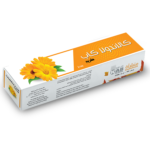تبييض وتفتيح مع آربو وايت
Arbutin
أربوتين هو أحد أكثر عوامل تفتيح البشرة وإزالة تصبغها انتشارًا في جميع أنحاء العالم. Arbutin ، مشتق b-D-glucopyranoside من الهيدروكينون ، هو مركب مشتق من النباتات بشكل طبيعي موجود في الأوراق المجففة لعدد من الأنواع النباتية المختلفة بما في ذلك عنب الدب (Arctostaphylos uva-ursi) ، العنبية ، التوت البري ، وأشجار الكمثرى. Arbutin ، يثبط نشاط التيروزيناز بشكل تنافسي ولكن بتركيزات غير سامة للخلايا بطريقة تعتمد على الجرعة في الخلايا الصباغية المستزرعة.18. كما أنه يمنع نضج الميلانوسوم وهو أقل سمية للخلايا الصباغية من الهيدروكينون. على الرغم من أن التركيزات الأعلى قد تكون أكثر فاعلية ، إلا أن هناك مخاطر أكبر لفرط تصبغ متناقض.
التجارب ذات الشواهد حول علاج فرط التصبغ غير متوفرة. ومع ذلك ، فقد أظهرت العديد من الدراسات أن أربوتين أقل فعالية من حمض الكوجيك لفرط التصبغ. Deoxyarbutin هو مشتق موضعي مركب. أظهرت الدراسات أن له تحسنًا مستدامًا معززًا ، وتفتيحًا عامًا للبشرة ، ومظهرًا أمانًا يضاهي الهيدروكينون.19]
18. Maeda K, Fukuda M. Arbutin: Mechanism of its depigmenting action in human melanocyte culture. J Pharmacol Exp Ther. 1996;276:765–9. [PubMed] [Google Scholar]
19. Boissy RE, Visscher M, DeLong MA. DeoxyArbutin: A novel reversible tyrosinase inhibitor with effective in vivo skin lightening potency. Exp Dermatol. 2005;14:601–8. [PubMed] [Google Scholar]
Kojec acid:
يتم دمج العديد من البدائل في حمض كوجيك في مجموعة 2-هيدروكسي ميثيل. يتم تصنيع بعض مشتقات حمض الكوجيك وتقييمها لقدرتها على تثبيط أوكسيديز الأحماض الأمينية (DAAO). تعمل هذه النظائر كمجسات جزيئية مفيدة لاستكشاف موقع الارتباط الثانوي ، والذي يمكن استخدامه في تصميم مثبطات أكثر فعالية
27- M. Raje, et al.Synthesis of kojic acid derivatives as secondary binding site probes of D-amino acid oxidase
Bioorg. Med. Chem. Lett., 23 (13) (2013), pp. 3910-3913
يمكن أن يسبب تعرض جلد الإنسان للأشعة فوق البنفسجية العديد من الآفات الجلدية ، مثل حروق الشمس وسرطان الجلد والإجهاد التأكسدي ، وكلها تعتمد على كثافة وكمية الأشعة فوق البنفسجية [28،29]. يمكن استخدام KA كحامي للأشعة فوق البنفسجية ، مع القدرة على الحد من التأثير المثبط للتيروزيناز لفرط التصبغ [2 ، [30] ، [31] ، [32] ، [33] ، [34] ، [35] ، [36]]. جعلت الآثار الجانبية للهيدروكينون (HQ) كمنظف للبشرة مشهور من KA بديلاً مناسبًا في مستحضرات التجميل [2،37]. تصف هذه المراجعة وتناقش التطبيق والقدرة العالية لـ KA ، كعامل تفتيح في مستحضرات التجميل والرعاية الصحية
28-M.A. Ebrahimzadeh, et al.Correlation between sun protection factor and antioxidant activity, phenol and flavonoid contents of some medicinal plants
Iranian journal of pharmaceutical research: IJPR, 13 (3) (2014), p. 1041
29-N.S. Pour, et al.Sun protection for children: a review
J. Pediatr. Rev., 3 (1) (2015)
2-M. SaeediAn Overview of Cosmetics and Toiletries
30-J. Cabanes, S. Chazarra, F. Garcia–CarmonaKojic acid, a cosmetic skin whitening agent, is a slow‐binding inhibitor of catecholase activity of tyrosinase
J. Pharm. Pharmacol., 46 (12) (1994), pp. 982-985
31-E.V. Curto, et al.Inhibitors of mammalian melanocyte tyrosinase: in vitro comparisons of alkyl esters of gentisic acid with other putative inhibitors
Biochem. Pharmacol., 57 (6) (1999), pp. 663-672
33-K. Sasaki, F. YoshizakiNobiletin as a tyrosinase inhibitor from the peel of Citrus fruit
Biol. Pharm. Bull., 25 (6) (2002), pp. 806-808
32-Y.M. Kim, et al.Oxyresveratrol and hydroxystilbene compounds inhibitory effect on tyrosinase and mechanism of action
J. Biol. Chem., 277 (18) (2002), pp. 16340-16344
34-M. Ishikawa, I. Kawase, F. IshiiCombination of amino acids reduces pigmentation in B16F0 melanoma cells
Biol. Pharm. Bull., 30 (4) (2007), pp. 677-681
35-P. Donsing, N. Limpeanchob, J. ViyochEvaluation of the effect of Thai breadfruit’s heartwood extract on melanogenesis-inhibitory and antioxidation activities
J. Cosmet. Sci., 59 (1) (2008), pp. 41-58
36-O. Abdel-Halim, et al.A new tyrosinase inhibitor from Crinum yemense as potential treatment for hyperpigmentation
Die Pharmazie-An International Journal of Pharmaceutical Sciences, 63 (5) (2008), pp. 405-407
37-S. Emami, et al.Kojic acid and its manganese and zinccomplexes as potential radioprotective agents
Bioorg. Med. Chem. Lett., 17 (1) (2007), pp. 45-48
 Previous Post
Previous Post Next Post
Next Post